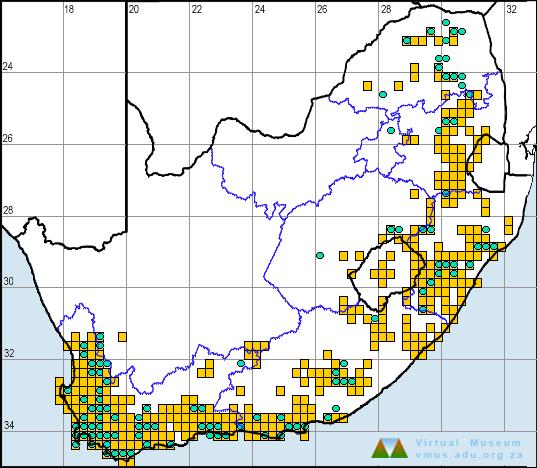View the above photo record (by Felicity Grundlingh) in FrogMAP here.
Find the Clicking Stream Frog in the FBIS database (Freshwater Biodiversity Information System) here.
Family Pyxicephalidae
CLICKING STREAM FROG – Strongylopus grayii
(Smith, 1849)
Identification

Photo by Ryan Tippett
Habitat
S. grayii is found in the winter-rainfall region of Western Cape Province, and in the summer-rainfall region to the north. Annual rainfall is 250–2000 mm in the winter-rainfall region, and 500–1000 mm in the summer-rainfall region. The species inhabits the entire Fynbos Biome as well as parts of the Succulent Karoo, Nama Karoo, Savanna, Grassland, Thicket and Forest biomes. Outside the relatively temperate, southwestern parts of its range, S. grayii is largely restricted to uplands.
Breeding habitat includes small dams, ponds, pools, ditches and shallow seeps. The species exhibits a wide tolerance to water quality, breeding, for example, in brackish pools along the coast within the spray zone and in flooded refuse pits.
Behaviour
This is one of the few frog species that breeds in the winter in the winter-rainfall region, and in summer in the summer-rainfall region. Males call throughout the day and night in the rainy season. The call site is often well concealed by vegetation or leaf litter at the water’s edge and the males are cryptic and difficult to locate.
About 250–350 eggs are laid, usually out of the water, up to 30 cm from its edge. They are deposited singly or in groups, in a single layer, in moss, under leaves, on mud or in crevices under rocks (Wager 1965; Channing 2001). In wet weather, tadpoles emerge from the egg capsules after 5 days and enter the water, but in dry weather they can survive in the capsules for as long as 63 days (Hewitt 1937). Development takes place over a period of 3–6 months (Wager 1965; Du Preez 1996).
The Yellow-billed Egret Egretta intermedia has been observed preying on these frogs in the southwest (J.A. Harrison pers. comm.)
Status and Conservation
This widespread and abundant species is not threatened or in need of specific conservation action.
Distribution
S. grayii is endemic to the atlas region where it is widely distributed. Its distribution extends from Western Cape Province, eastward through Eastern Cape Province and Lesotho to KwaZulu-Natal, and northward through Swaziland and Mpumalanga to Limpopo Province. The species has a marginal distribution in the Northern Cape Province and the Free State. S. grayii occurs from sea level to 1800 m in the mountains of Lesotho and Swaziland.
The atlas data are accurate but incomplete in the high-lying, northern parts of its range. In the southwest it is one of the most common and frequently recorded species in lowlands.

Further Resources
Virtual Museum (FrogMAP > Search VM > By Scientific or Common Name)
More common names: Kliklangtoonpadda (Afrikaans)
Recommended citation format for this species text:
Channing A, Tippett RM. Clicking Stream Frog Strongylopus grayii. BDI, Cape Town.
Available online at http://thebdi.org/2021/11/02/clicking-stream-frog-strongylopus-grayii/
Recommended citation format:
This species text has been updated and expanded from the text in the
2004 frog atlas. The reference to the text and the book are as follows:
Channing A 2004 Strongylopus grayii Clicking Stream Frog. In Minter LR
et al 2004.
Minter LR, Burger M, Harrison JA, Braack HH, Bishop PJ, Kloepfer D (eds)
2004. Atlas and Red Data Book of the Frogs of South Africa, Lesotho and
Swaziland. Smithsonian Institution, Washington, and Avian Demography
Unit, Cape Town.

